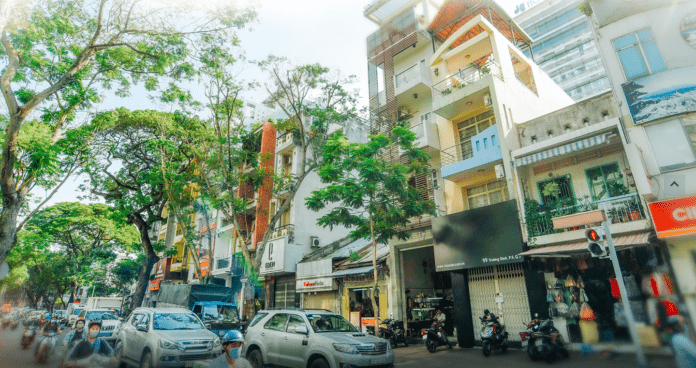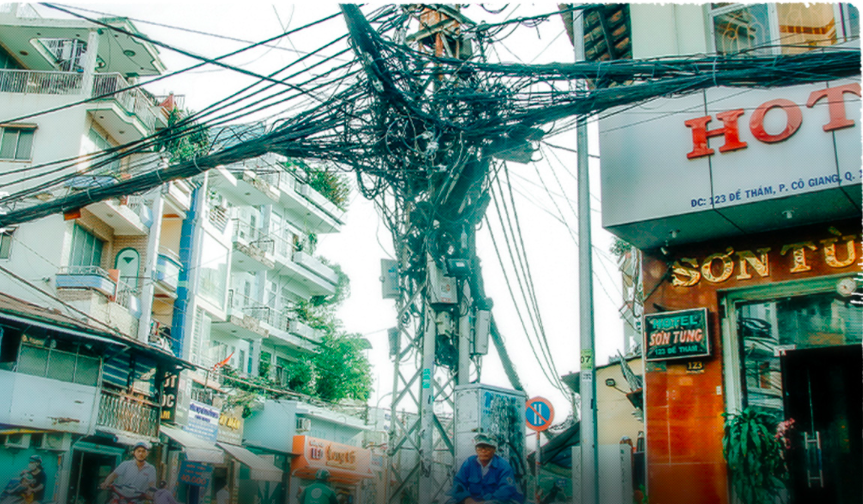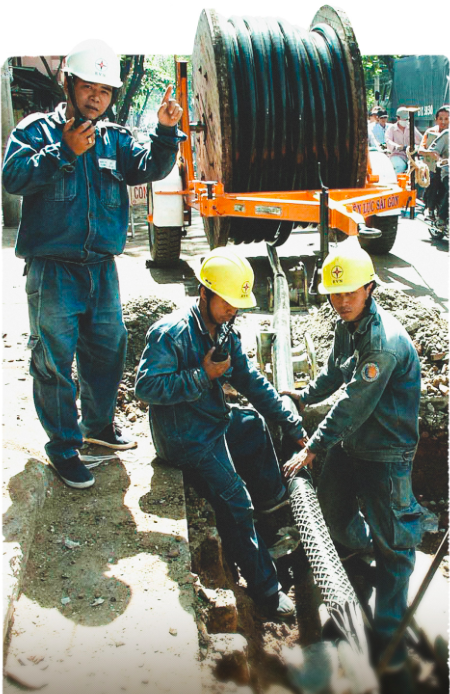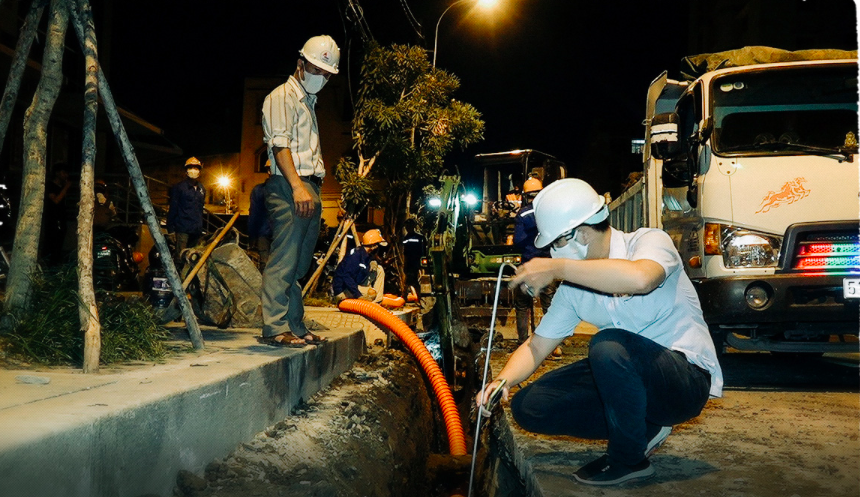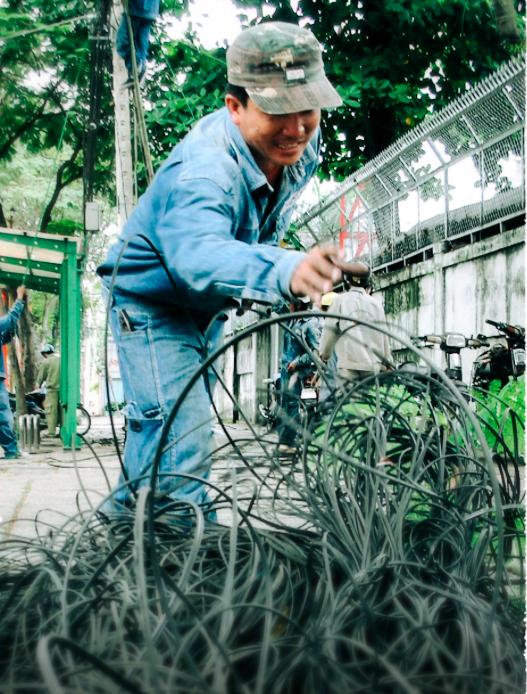The removal of the city’s iconic yet troubling scene has taken decades, involving dozens of agencies.
|
|
| A messy electricity pole is seen at the De Tham-Co Bac intersection in District 1, Ho Chi Minh City, January 1, 2018. Photo: Hoang Dong – Quang Dinh / Tuoi Tre |
From piloting to mass implementing
The disappearance of messy nests of wires gives breathing space to the city and helps to boost sales of street front shops.
Linh, a shop owner on Vo Thi Sau Street in District 3, recalled 2016 when overhead wires still plagued and mostly covered up the building’s façade.
“As the tangle became a mess, it was tightened up with metal rings,” she recounted.
“We lived on thin ice back then, worrying a short circuit might have caused a devastating blaze.
“In 2017, those wires started being unraveled and grounded.”
|
|
| Workers of Ho Chi Minh City Power Corporation pull out new underground electrical cables on Hai Ba Trung Street, District 1, Ho Chi Minh City, November 8, 2020. Photo: Nguyen Cong Thanh / Tuoi Tre |
Linh told Tuoi Tre she used to set up a shop sign in front of the building which encroached on the sidewalk.
“Since the wires were buried, the shop façade has been visible from afar, allowing us to attract more customers than before,” she added.
Nguyen Van Anh, a resident of District 6, said electrical and telecommunications cables in her neighborhood were only grounded in 2018.
Before, the wiring formed a convoluted net right in front of her house.
“It looked weighty,” she said.
“I worried that once the pole might no longer bear such a burden and collapse, my house would have been destroyed.
“It was such a relief when the net was buried.”
|
|
| Workers construct an electricity grid on Hai Ba Trung Street, District 1, Ho Chi Minh City, August 20, 2013. Photo: Quang Dinh / Tuoi Tre |
Ho Chi Minh City’s plan of wire burial was first developed between 2003 and 2005.
The city’s electricity company piloted grounding its electrical cables on Le Loi, Le Duan, and Nguyen Hue Streets.
The first-hand effort, however, did not completely address the wire plague since communications and lighting cables were still overhung.
The plan’s next phase took place in 2009-10 with the company implementing five projects of burying electrical and communications wires in some central areas including around the Ho Chi Minh City People’s Committee building, Ben Thanh Market, and on the main streets of Tran Hung Dao, Le Thanh Ton, and Truong Dinh.
|
|
| Technicians check a cable trench’s depth. Photo: V.A / Tuoi Tre |
These projects adopted a multi-objective approach of not only centralizing the management of metropolitan technical infrastructure but also upgrading the city’s sidewalk system.
The schemes started expanding in 2015 with electricity and communications sectors joining hands to bury tangled wires in District 1 and District 3.
Messy electricity poles have no longer been seen in the city center since the end of 2020 while the work has been continuing in outlying districts.
|
|
| Workers remove tangled wires at the Pasteur-Ly Tu Trong intersection in preparation for undergrounding in Ho Chi Minh City, August 8, 2011. Photo: Nguyen Cong Thanh / Tuoi Tre |
Steering committee needed
The undergrounding used to be done at the stakeholders’ discretion.
There was a time when sidewalks would be dug up once by the electricity company that had buried their wires, then telecom agencies came to do it again.
Messy construction provoked an uproar from residents.
Realizing the issue in 2014, the city government tasked the Department of Information and Communications with cooperating with the Department of Industry and Trade, Ho Chi Minh City Power Corporation, and related agencies in forming a steering committee responsible for coordinating the burial of electrical and communications cables.
|
|
| A worker cleans up old wires after they were removed on Truong Dinh Street, Ho Chi Minh City, May 12, 2009. Photo: Nguyen Cong Thanh / Tuoi Tre |
The cooperation has proven its role in changing the cityscape, preventing fire and contributing to the development of sustainable neighborhoods, according to Le Quoc Cuong, deputy director of the Department of Information and Communications.
As the project has been expanded, Cuong stressed upon the comprehensive cooperation and support from districts’ authorities along with awareness-raising efforts for people on the need of wire burial.
“It is an urgent demand to develop a procedure and mechanism able to link investors of public infrastructure projects, project managing agencies, sewage agencies, electricity and telecom companies in setting up the underground cable system aligned with traffic constructions,” said Cuong.
|
|
| The Pasteur-Ly Tu Trong intersection after the burial of overhead wires. Photo: Quang Dinh / Tuoi Tre |
In the past 10 years, under the city authorities’ command, some 240 cable-grounding projects have been completed on 195 streets, burying nearly 2,200km of electrical wires.
From 2021 to 2025, the city aims to bury nearly 1,300 more kilometers of electrical cables.
These ambitious undergrounding projects depend on efforts of authorities to develop an urban underground infrastructure plan as a reference system for similar efforts, according to Nguyen Van Thanh, director of Ho Chi Minh City Power Corporation.
Besides, it is necessary to have citizens understand the need of these projects in improving living standards and the cityscape of Vietnam’s economic engine.
“We plan to recommend the city authorities to use 3D Geographic Information System in managing underground infrastructure, at the same time, providing data for the city’s public service portal.
“The technology is expected to create favorable conditions for the design, negotiation, implementation and investment of any undergrounding project.
“The company will also ask the authorities to accelerate assistance policies, offer incentives including increasing the current loan interest support of 50 percent to 100 percent.”
Banh Duc Hoai, deputy director of Ho Chi Minh City Power Corporation
Le Quoc Cuong, deputy director of Ho Chi Minh City’s Department of Information and Communications, said the city was the vanguard in tidying up and undergrounding telecom cables, funded by private agencies.
The city also pioneered the use of Geographic Information System in managing sectors of electricity, sewage and telecommunication as well as developing the public service portal named 1002, which was later duplicated in other provinces.
The telecommunication sector’s undergrounding was first conducted in 2000 on Le Duan Street.
Local authorities aimed to avoid replacing an overhead mess with an underground one by tasking the department with monitoring the burial of wires.
“Some other cities have followed Ho Chi Minh City in undergrounding cables,” said Cuong.
“Even in Ho Chi Minh City, people living in small alleys worked with authorities to bury wires to ensure safety.”
Like us on Facebook or follow us on Twitter to get the latest news about Vietnam!

